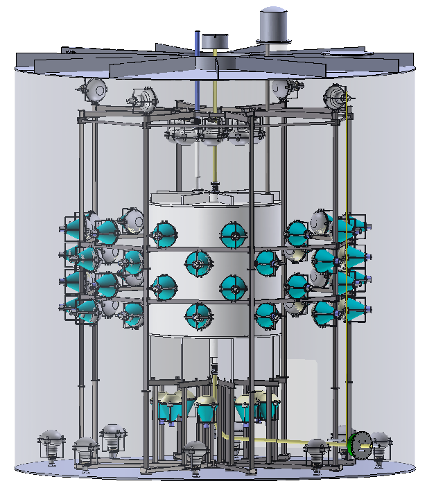OSIRIS

The detector:
The OSIRIS detector design, consisting of two optically separated vessels, is shown in the figure above. The inner vessel is an acrylic cylinder with a diameter and height of 3m each. It holds ~20 tons of liquid scintillator and is observed by 64 20''-PMTs. These PMTs are held by a steel frame which is fully contained in the outer vessel. Due to the purpose of OSIRIS to constantly monitor the LS quality, it has an inlet on the top and an outlet in the bottom of the inner vessel: both equipped with a diffuser to ensure an equal distribution of the scintillator in the vessel.
The outer vessel is a stainless steel cylinder filled with water, which serves as a buffer volume to shield against external radioactivity from the surrounding rock. It is equipped with additional 12 20''-PMTs that will detect the Cherenkov light from cosmogenic muons.
The readout design of the PMTs will use a novel approach. To maximize the quality of the signal, the readout electronics as well as the digitizer is placed directly inside the base of the PMT. This enables better impedance matching of the PMT base and therefore a higher quality of the signal. The analogue-to-digital converter chip was developed in the ZEA-2 institute of FZJ. OSIRIS will run with a trigger-less readout scheme. The waveforms from individual PMTs will be sent, together with a synchronized time stamp, to the outside DAQ system. Here, a dedicated software will sort the waveforms (based on their time-stamps) and will build the "offline trigger". The IKP group is involved in the development of the latter.
Physics goals:
The purpose of the Online Scintillator Internal Radioactivity Investigation System (OSIRIS) is to monitor whether the LS meets these requirements during the whole process of filling the 20 kton of LS into the JUNO central detector. OSIRIS can contain 20 ton of LS and the samples from each purification batch will be constantly flowing throuh it.
The principle of measuring the levels of $^{238}$U and $^{232}$Th contamination lies in identification of the fast time-coincident decays of the isotope pairs ${}^{214}$Bi-${}^{214}$Po and ${}^{212}$Bi-${}^{212}$Po, respectively. In addition, OSIRIS will be able to measure the $^{14}$C concentration down to a $^{14}$C/$^{12}$C ratio of ${10}^{-17}$ at 90% confidence level.
IKP contribution:
OSIRIS is mainly developed by the German part inside the JUNO collaboration. The responsibility of the IKP group is the development of the source calibration system. The radioactive sources will be employed with the help of the ACU (Automatic Calibration Unit) kindly provided by the Daya Bay collaboration. A substantial effort is ongoing in order to adapt the unit in OSIRIS and plan the whole calibration procedure with a minimal risk of the contamination of the LS.
The group was also involved in the construction of the OSIRIS Monte Carlo. Worth to mention is the implementation of the biasing mechanism for an efficient simulation of the external background, previously applied by the Borexino collaboration.
The tool for the estimation of the OSIRIS sensitivity as radio-activity monitor was also developed here and was used to determine the optimal detector design parameters, as is the number of PMTs, their distance to the inner vessel, or to estimate the impact of different radioactive contaminants.
For possible Bachelor and Master thesis topics please refer to here or contact Prof. Livia Ludhova.